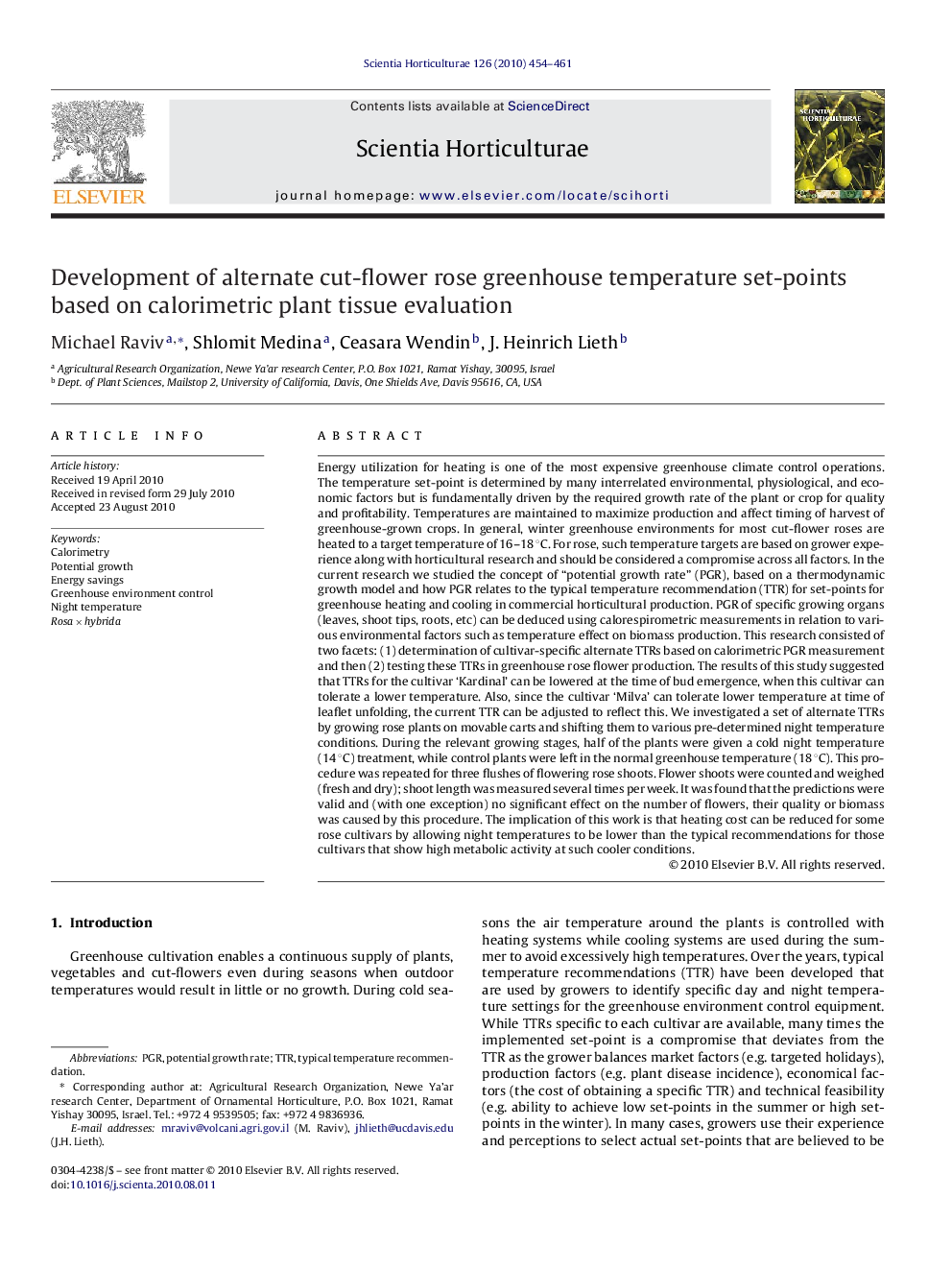| کد مقاله | کد نشریه | سال انتشار | مقاله انگلیسی | نسخه تمام متن |
|---|---|---|---|---|
| 4568724 | 1331310 | 2010 | 8 صفحه PDF | دانلود رایگان |

Energy utilization for heating is one of the most expensive greenhouse climate control operations. The temperature set-point is determined by many interrelated environmental, physiological, and economic factors but is fundamentally driven by the required growth rate of the plant or crop for quality and profitability. Temperatures are maintained to maximize production and affect timing of harvest of greenhouse-grown crops. In general, winter greenhouse environments for most cut-flower roses are heated to a target temperature of 16–18 °C. For rose, such temperature targets are based on grower experience along with horticultural research and should be considered a compromise across all factors. In the current research we studied the concept of “potential growth rate” (PGR), based on a thermodynamic growth model and how PGR relates to the typical temperature recommendation (TTR) for set-points for greenhouse heating and cooling in commercial horticultural production. PGR of specific growing organs (leaves, shoot tips, roots, etc) can be deduced using calorespirometric measurements in relation to various environmental factors such as temperature effect on biomass production. This research consisted of two facets: (1) determination of cultivar-specific alternate TTRs based on calorimetric PGR measurement and then (2) testing these TTRs in greenhouse rose flower production. The results of this study suggested that TTRs for the cultivar ‘Kardinal’ can be lowered at the time of bud emergence, when this cultivar can tolerate a lower temperature. Also, since the cultivar ‘Milva’ can tolerate lower temperature at time of leaflet unfolding, the current TTR can be adjusted to reflect this. We investigated a set of alternate TTRs by growing rose plants on movable carts and shifting them to various pre-determined night temperature conditions. During the relevant growing stages, half of the plants were given a cold night temperature (14 °C) treatment, while control plants were left in the normal greenhouse temperature (18 °C). This procedure was repeated for three flushes of flowering rose shoots. Flower shoots were counted and weighed (fresh and dry); shoot length was measured several times per week. It was found that the predictions were valid and (with one exception) no significant effect on the number of flowers, their quality or biomass was caused by this procedure. The implication of this work is that heating cost can be reduced for some rose cultivars by allowing night temperatures to be lower than the typical recommendations for those cultivars that show high metabolic activity at such cooler conditions.
Research highlights▶ Energy utilization for heating is one of the most expensive greenhouse climate control operations. ▶ This bi-national project demonstrates the feasibility of replacing long-term, costly greenhouse experiments, intended to identify optimal set-point temperature with short and relatively simple laboratory measurements, based on microcalorimetry. ▶ To this aim we used a thermodynamic growth model. ▶ This calorespirometry-based model facilitates the measurement of temperature effect on “potential growth rate” (PGR), and how PGR relates to the typical temperature recommendation (TTR) for set-points for greenhouse heating. ▶ Since roses are pinched or pruned for specific harvest dates (e.g. Valentine day), the identification of temperature preferences of specific organs (such as emerging buds or developing leaflets) may allow the grower to lower the temperature during specific time frames, when plant development is not sensitive to such temperature. ▶ This may enable a significant energy savings.
Journal: Scientia Horticulturae - Volume 126, Issue 4, 29 October 2010, Pages 454–461